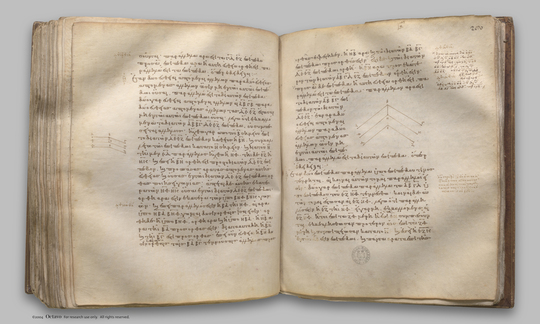index prev next | digilib folio 284

If two straight lines meeting one another be parallel to two straight lines meeting one another, not being in the same plane, the planes through them are parallel.
| Ἐὰν δύο εὐθεῖαι ἁπτόμεναι ἀλλήλων παρὰ δύο εὐθείας ἁπτομένας ἀλλήλων ὦσι μὴ ἐν τῷ αὐτῷ ἐπιπέδῳ οὖσαι, παράλληλά ἐστι τὰ δι' αὐτῶν ἐπίπεδα. Δύο γὰρ εὐθεῖαι ἁπτόμεναι ἀλλήλων αἱ ΑΒ, ΒΓ παρὰ δύο εὐθείας ἁπτομένας ἀλλήλων τὰς ΔΕ, ΕΖ ἔστωσαν μὴ ἐν τῷ αὐτῷ ἐπιπέδῳ οὖσαι: λέγω, ὅτι ἐκβαλλόμενα τὰ διὰ τῶν ΑΒ, ΒΓ, ΔΕ, ΕΖ ἐπίπεδα οὐ συμπεσεῖται ἀλλήλοις. Ἤχθω γὰρ ἀπὸ τοῦ Β σημείου ἐπὶ τὸ διὰ τῶν ΔΕ, ΕΖ ἐπίπεδον κάθετος ἡ ΒΗ καὶ συμβαλλέτω τῷ ἐπιπέδῳ κατὰ τὸ Η σημεῖον, καὶ διὰ τοῦ Η τῇ μὲν ΕΔ παράλληλος ἤχθω ἡ ΗΘ, τῇ δὲ ΕΖ ἡ ΗΚ. καὶ ἐπεὶ ἡ ΒΗ ὀρθή ἐστι πρὸς τὸ διὰ τῶν ΔΕ, ΕΖ ἐπίπεδον, καὶ πρὸς πάσας ἄρα τὰς ἁπτομένας αὐτῆς εὐθείας καὶ οὔσας ἐν τῷ διὰ τῶν ΔΕ, ΕΖ ἐπιπέδῳ ὀρθὰς ποιήσει γωνίας. ἅπτεται δὲ αὐτῆς ἑκατέρα τῶν ΗΘ, ΗΚ οὖσα ἐν τῷ διὰ τῶν ΔΕ, ΕΖ ἐπιπέδῳ: ὀρθὴ ἄρα ἐστὶν ἑκατέρα τῶν ὑπὸ ΒΗΘ, ΒΗΚ γωνιῶν. καὶ ἐπεὶ παράλληλός ἐστιν ἡ ΒΑ τῇ ΗΘ, αἱ ἄρα ὑπὸ ΗΒΑ, ΒΗΘ γωνίαι δυσὶν ὀρθαῖς ἴσαι εἰσίν. ὀρθὴ δὲ ἡ ὑπὸ ΒΗΘ: ὀρθὴ ἄρα καὶ ἡ ὑπὸ ΗΒΑ: ἡ ΗΒ ἄρα τῇ ΒΑ πρὸς ὀρθάς ἐστιν. διὰ τὰ αὐτὰ δὴ ἡ ΗΒ καὶ τῇ ΒΓ ἐστι πρὸς ὀρθάς. ἐπεὶ οὖν εὐθεῖα ἡ ΗΒ δυσὶν εὐθείαις ταῖς ΒΑ, ΒΓ τεμνούσαις ἀλλήλας πρὸς ὀρθὰς ἐφέστηκεν, ἡ ΗΒ ἄρα καὶ τῷ διὰ τῶν ΒΑ, ΒΓ ἐπιπέδῳ πρὸς ὀρθάς ἐστιν. [ διὰ τὰ αὐτὰ δὴ ἡ ΒΗ καὶ τῷ διὰ τῶν ΗΘ, ΗΚ ἐπιπέδῳ πρὸς ὀρθάς ἐστιν. τὸ δὲ διὰ τῶν ΗΘ, ΗΚ ἐπίπεδόν ἐστι τὸ διὰ τῶν ΔΕ, ΕΖ: ἡ ΒΗ ἄρα τῷ διὰ τῶν ΔΕ, ΕΖ ἐπιπέδῳ ἐστὶ πρὸς ὀρθάς. ἐδείχθη δὲ ἡ ΗΒ καὶ τῷ διὰ τῶν ΑΒ, ΒΓ ἐπιπέδῳ πρὸς ὀρθάς ]. πρὸς ἃ δὲ ἐπίπεδα ἡ αὐτὴ εὐθεῖα ὀρθή ἐστιν, παράλληλά ἐστι τὰ ἐπίπεδα: παράλληλον ἄρα ἐστὶ τὸ διὰ τῶν ΑΒ, ΒΓ ἐπίπεδον τῷ διὰ τῶν ΔΕ, ΕΖ. Ἐὰν ἄρα δύο εὐθεῖαι ἁπτόμεναι ἀλλήλων παρὰ δύο εὐθείας ἁπτομένας ἀλλήλων ὦσι μὴ ἐν τῷ αὐτῷ ἐπιπέδῳ, παράλληλά ἐστι τὰ δι' αὐτῶν ἐπίπεδα: ὅπερ ἔδει δεῖξαι. | If two straight lines meeting one another be parallel to two straight lines meeting one another, not being in the same plane, the planes through them are parallel. For let the two straight lines AB, BC meeting one another be parallel to the two straight lines DE, EF meeting one another, not being in the same plane; I say that the planes produced through AB, BC and DE, EF will not meet one another. For let BG be drawn from the point B perpendicular to the plane through DE, EF [XI. 11], and let it meet the plane at the point G; through G let GH be drawn parallel to ED, and GK parallel to EF. [I. 31] Now, since BG is at right angles to the plane through DE, EF, therefore it will also make right angles with all the straight lines which meet it and are in the plane through DE, EF. [XI. Def. 3] But each of the straight lines GH, GK meets it and is in the plane through DE, EF; therefore each of the angles BGH, BGK is right. And, since BA is parallel to GH, [XI. 9] therefore the angles GBA, BGH are equal to two right angles. [I. 29] But the angle BGH is right; therefore the angle GBA is also right; therefore GB is at right angles to BA. For the same reason GB is also at right angles to BC. Since then the straight line GB is set up at right angles to the two straight lines BA, BC which cut one another, therefore GB is also at right angles to the plane through BA, BC. [XI. 4] But planes to which the same straight line is at right angles are parallel; [XI. 14] therefore the plane through AB, BC is parallel to the plane through DE, EF. |